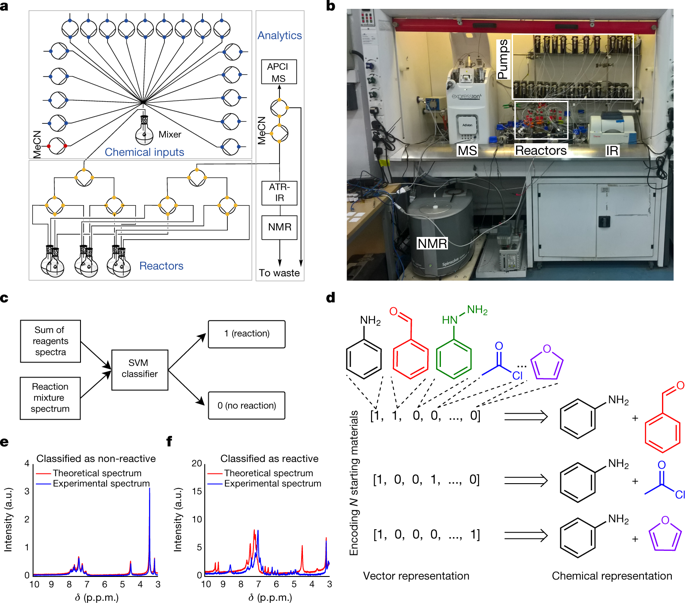Our official English website, www.x-mol.net, welcomes your
feedback! (Note: you will need to create a separate account there.)
Controlling an organic synthesis robot with machine learning to search for new reactivity
Nature ( IF 50.5 ) Pub Date : 2018-07-01 , DOI: 10.1038/s41586-018-0307-8 Jarosław M Granda 1 , Liva Donina 1 , Vincenza Dragone 1 , De-Liang Long 1 , Leroy Cronin 1
Nature ( IF 50.5 ) Pub Date : 2018-07-01 , DOI: 10.1038/s41586-018-0307-8 Jarosław M Granda 1 , Liva Donina 1 , Vincenza Dragone 1 , De-Liang Long 1 , Leroy Cronin 1
Affiliation

|
The discovery of chemical reactions is an inherently unpredictable and time-consuming process1. An attractive alternative is to predict reactivity, although relevant approaches, such as computer-aided reaction design, are still in their infancy2. Reaction prediction based on high-level quantum chemical methods is complex3, even for simple molecules. Although machine learning is powerful for data analysis4,5, its applications in chemistry are still being developed6. Inspired by strategies based on chemists’ intuition7, we propose that a reaction system controlled by a machine learning algorithm may be able to explore the space of chemical reactions quickly, especially if trained by an expert8. Here we present an organic synthesis robot that can perform chemical reactions and analysis faster than they can be performed manually, as well as predict the reactivity of possible reagent combinations after conducting a small number of experiments, thus effectively navigating chemical reaction space. By using machine learning for decision making, enabled by binary encoding of the chemical inputs, the reactions can be assessed in real time using nuclear magnetic resonance and infrared spectroscopy. The machine learning system was able to predict the reactivity of about 1,000 reaction combinations with accuracy greater than 80 per cent after considering the outcomes of slightly over 10 per cent of the dataset. This approach was also used to calculate the reactivity of published datasets. Further, by using real-time data from our robot, these predictions were followed up manually by a chemist, leading to the discovery of four reactions.A robot instructed by a machine learning algorithm and coupled with real-time spectroscopic systems provides fast and accurate reaction outcome predictions and reactivity assessments, leading to the discovery of new reactions.
中文翻译:

用机器学习控制有机合成机器人以寻找新的反应性
化学反应的发现本质上是一个不可预测且耗时的过程1。一个有吸引力的替代方法是预测反应性,尽管相关方法,如计算机辅助反应设计,仍处于起步阶段。基于高级量子化学方法的反应预测很复杂3,即使对于简单的分子也是如此。尽管机器学习在数据分析方面非常强大 4、5,但其在化学中的应用仍在开发中 6。受基于化学家直觉的策略的启发,我们提出由机器学习算法控制的反应系统可能能够快速探索化学反应的空间,尤其是在专家训练的情况下。在这里,我们展示了一种有机合成机器人,它可以比人工更快地进行化学反应和分析,以及在进行少量实验后预测可能的试剂组合的反应性,从而有效地导航化学反应空间。通过使用机器学习进行决策,通过化学输入的二进制编码实现,可以使用核磁共振和红外光谱实时评估反应。在考虑了略高于 10% 的数据集的结果后,机器学习系统能够以超过 80% 的准确度预测大约 1000 种反应组合的反应性。这种方法还用于计算已发布数据集的反应性。此外,通过使用我们机器人的实时数据,化学家手动跟进这些预测,从而发现了四种反应。
更新日期:2018-07-01
中文翻译:

用机器学习控制有机合成机器人以寻找新的反应性
化学反应的发现本质上是一个不可预测且耗时的过程1。一个有吸引力的替代方法是预测反应性,尽管相关方法,如计算机辅助反应设计,仍处于起步阶段。基于高级量子化学方法的反应预测很复杂3,即使对于简单的分子也是如此。尽管机器学习在数据分析方面非常强大 4、5,但其在化学中的应用仍在开发中 6。受基于化学家直觉的策略的启发,我们提出由机器学习算法控制的反应系统可能能够快速探索化学反应的空间,尤其是在专家训练的情况下。在这里,我们展示了一种有机合成机器人,它可以比人工更快地进行化学反应和分析,以及在进行少量实验后预测可能的试剂组合的反应性,从而有效地导航化学反应空间。通过使用机器学习进行决策,通过化学输入的二进制编码实现,可以使用核磁共振和红外光谱实时评估反应。在考虑了略高于 10% 的数据集的结果后,机器学习系统能够以超过 80% 的准确度预测大约 1000 种反应组合的反应性。这种方法还用于计算已发布数据集的反应性。此外,通过使用我们机器人的实时数据,化学家手动跟进这些预测,从而发现了四种反应。











































 京公网安备 11010802027423号
京公网安备 11010802027423号